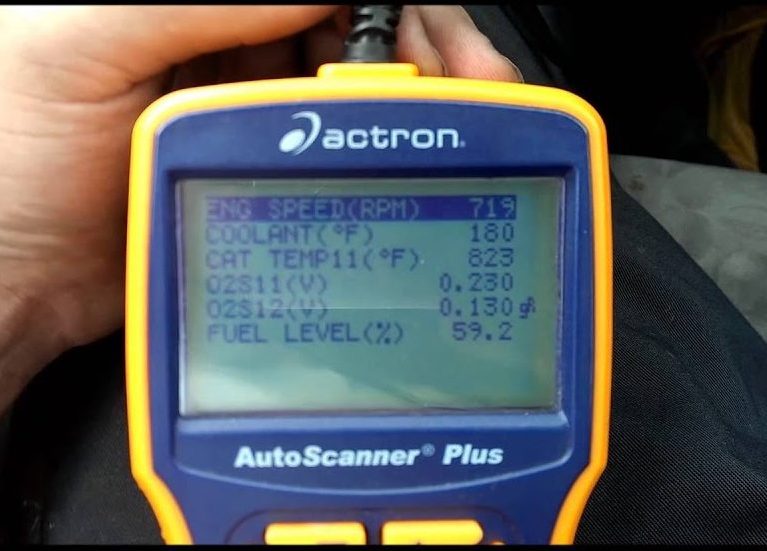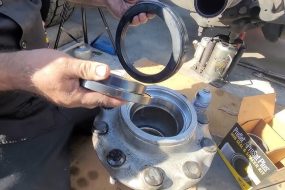
The error codes in every vehicle are an indication that something is wrong with the vehicle. The code is there to notify you of a new problem and the need to have it fixed. The code always comes with a warning light which stays on the dashboard until the problem is fixed.
The P0300 Code on the other hand is a code that indicates a random engine misfire. It is a code that triggers when the car’s computer detects that the engine’s cylinders are misfiring without a specific pattern or in a random manner.
However, the P0300 code can be caused by various issues, such as fuel delivery problems, ignition system issues, vacuum leaks, or mechanical problems within the engine, etc., but can a bad catalytic converter cause a P0300 code?
Yes, a bad catalytic converter can cause a P0300 random/multiple cylinder misfire code if the catalytic converter is clogged without enough space for the exhaust to breathe causing a back pressure where the unburnt gas is ignited inside the catalytic converter.
Can a Bad Catalytic Converter Cause a P0300 Code?
Yes, a bad catalytic converter can indirectly cause a p0300 code which indicates a random or multiple-cylinder misfire in the engine.
When we say “indirectly”, we mean that a bad catalytic converter does not always cause a P0300 code just like a bad spark plug in cylinder 1 causes a P0301 code.
However, a bad catalytic converter can cause a P0300 code if there is excessive exhaust backpressure impeding the flow of exhaust gas out of the engine.
This is possible if the catalytic converter is severely clogged or damaged, affecting the engine performance and potentially leading to misfires in multiple cylinders. If the misfires are severe enough, it could trigger a P0300 code.
Meanwhile, if the catalytic converter is bad, it can affect the engine, fuel delivery, ignition, or sensors. These problems, if left unresolved, can cause misfires and trigger a P0300 code.
To fix a P0300 code, it’s important to diagnose and fix the root cause of the misfires. You can do this by inspecting and testing components related to the ignition system, fuel system, and sensors, as well as checking for vacuum leaks and exhaust restrictions.
If after checking you cannot find anything, then inspect your catalytic converter to be sure it’s not clogged.If you started having the P0300 code the same time your catalytic converter started reading an error, code, you need to inspect the converter to be sure it is not clogged.
What to Do When Catalytic Converter Causes a P0300 Code?
Once you discover that your catalytic converter is the culprit behind the random misfire P0300 code, you can start by observing why the catalytic converter is causing the code. Is it clogged, or damaged, or did you use the wrong catalytic converter designed for your car?
If the catalytic converter is clogged, you can start fixing it by using a catalytic converter cleaner to clear the clogs, If it fails to clear the clogs, you may need to remove the converter and clean the clogs yourself.
If the catalytic converter is damaged, you can fix the issue by replacing the catalytic converter with a functional one.
If you use a wrong catalytic converter that does not work with your kind of car, you can start by either removing it and replacing it with the accurate converter or using a 02 sensor spacer to trick the ECM into thinking the converter is there.
You should also check the o2 sensor to be sure it’s not the one causing the ECM to read the P0300 code. This is because the oxygen sensors play a crucial role in monitoring the performance of the catalytic converter. Check the O2 sensors for proper operation and replace them if necessary.
What Code Can a Bad Catalytic Converter Cause?
A bad or failing catalytic converter can cause several codes relating to the performance of the catalytic converter itself. These codes are:
- P0420 – Catalyst System Efficiency Below Threshold (Bank 1): When your catalytic converter goes bad, it can throw P0420 code which means that the catalytic converter on bank 1 is not operating efficiently. It suggests that the converter is not effectively reducing emissions, which can be due to a malfunction, clogging, or damage. It can also happen if you use a wrong catalytic converter designed to work with your car’s computer.
- P0430 – Catalyst System Efficiency Below Threshold (Bank 2): The PO230 is similar to P0420, but it pertains to the catalytic converter on bank 2 of a V6 or V8 engine. It signifies that the converter is not functioning as expected.
- P0421 – Warm-Up Catalyst Efficiency Below Threshold (Bank 1): This code means that the catalytic converter on bank 1 is not reaching operating temperature quickly enough, which could be due to a problem with the converter or related components.
- P0431 – Warm-Up Catalyst Efficiency Below Threshold (Bank 2): The meaning of this code is similar to P0421 but for the catalytic converter on Bank 2. The catalytic converter on bank 2 is not reaching operating temperature quickly enough.
- P0422 – Main Catalyst Efficiency Below Threshold (Bank 1): This DTC indicates that the main catalytic converter on Bank 1 is not performing at the expected efficiency level.
- P0432 – Main Catalyst Efficiency Below Threshold (Bank 2): The meaning of this code is similar to P0422 but for the catalytic converter on Bank 2.
- P0423 – Heated Catalyst Efficiency Below Threshold (Bank 1): This code is specific to vehicles with a heated catalytic converter. It suggests that the heated catalyst on bank 1 is not operating efficiently.
- P0433 – Heated Catalyst Efficiency Below Threshold (Bank 2): This code is similar to P0423 but for the heated catalyst on bank 2.
However, it is important to note that these codes are related to the catalytic converter’s performance and efficiency. If one or more of these codes are present, it means that there’s something wrong with the catalytic converter of the cylinders indicated in the code. It is left for you to find out why the problem is there and a solution to it.
Common Cause of the P0300 Code?
The most common causes of a P0300 random or multiple cylinder misfire code are bad spark plugs, ignition coils, vacuum leaks, faulty mass airflow sensors, clogged or dirty fuel injectors, etc.
Can Dirty Fuel Injectors Cause P0300?
Yes, dirty fuel injectors can cause a P0300 code because when fuel injectors become dirty or clogged, they can deliver fuel unevenly to the engine’s cylinders, leading to a lean or rich air-fuel mixture in certain cylinders.
This imbalance in the air-fuel mixture can result in misfires, which can trigger the P0300 code, indicating random or multiple-cylinder misfires.
Conclusion
Indeed, a bad catalytic converter can cause a p0300 code. However, for you to be able to fix a random misfire problem, you need to perform a series of tests and inspections to pinpoint the exact cause of the misfire.
These inspections include checking spark plugs and ignition coils, testing fuel injectors, examining the air intake system for leaks, and inspecting the engine’s mechanical components as well as the catalytic converter, etc. The specific repairs required will depend on the issue causing the random misfire.









